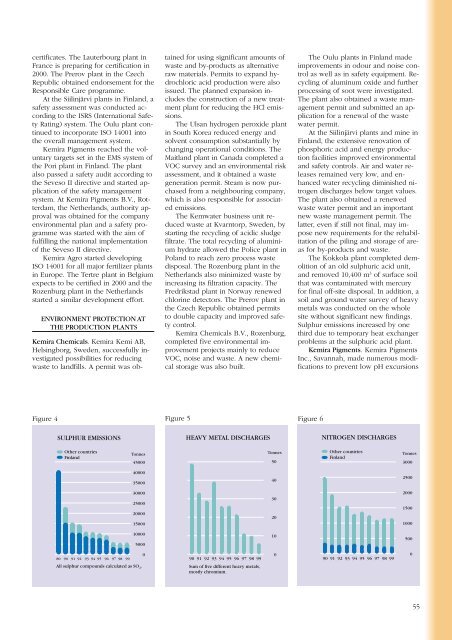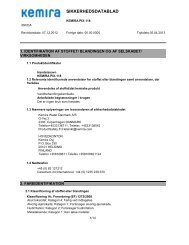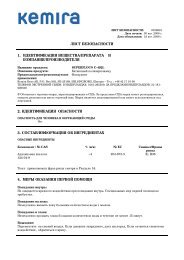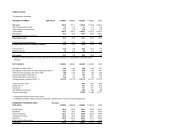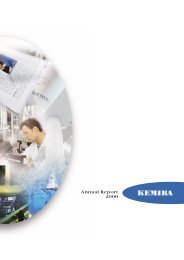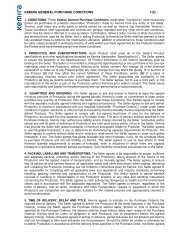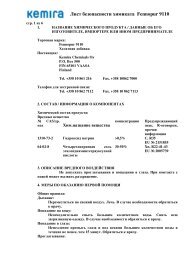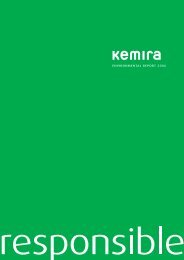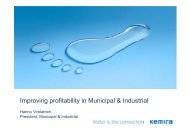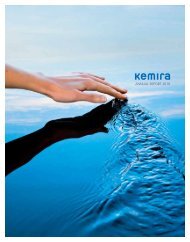Annual Report 1999 - Kemira
Annual Report 1999 - Kemira
Annual Report 1999 - Kemira
Create successful ePaper yourself
Turn your PDF publications into a flip-book with our unique Google optimized e-Paper software.
certificates. The Lauterbourg plant in<br />
France is preparing for certification in<br />
2000. The Prerov plant in the Czech<br />
Republic obtained endorsement for the<br />
Responsible Care programme.<br />
At the Siilinjärvi plants in Finland, a<br />
safety assessment was conducted according<br />
to the ISRS (International Safety<br />
Rating) system. The Oulu plant continued<br />
to incorporate ISO 14001 into<br />
the overall management system.<br />
<strong>Kemira</strong> Pigments reached the voluntary<br />
targets set in the EMS system of<br />
the Pori plant in Finland. The plant<br />
also passed a safety audit according to<br />
the Seveso II directive and started application<br />
of the safety management<br />
system. At <strong>Kemira</strong> Pigments B.V., Rotterdam,<br />
the Netherlands, authority approval<br />
was obtained for the company<br />
environmental plan and a safety programme<br />
was started with the aim of<br />
fulfilling the national implementation<br />
of the Seveso II directive.<br />
<strong>Kemira</strong> Agro started developing<br />
ISO 14001 for all major fertilizer plants<br />
in Europe. The Tertre plant in Belgium<br />
expects to be certified in 2000 and the<br />
Rozenburg plant in the Netherlands<br />
started a similar development effort.<br />
ENVIRONMENT PROTECTION AT<br />
THE PRODUCTION PLANTS<br />
<strong>Kemira</strong> Chemicals. <strong>Kemira</strong> Kemi AB,<br />
Helsingborg, Sweden, successfully investigated<br />
possibilities for reducing<br />
waste to landfills. A permit was obtained<br />
for using significant amounts of<br />
waste and by-products as alternative<br />
raw materials. Permits to expand hydrochloric<br />
acid production were also<br />
issued. The planned expansion includes<br />
the construction of a new treatment<br />
plant for reducing the HCl emissions.<br />
The Ulsan hydrogen peroxide plant<br />
in South Korea reduced energy and<br />
solvent consumption substantially by<br />
changing operational conditions. The<br />
Maitland plant in Canada completed a<br />
VOC survey and an environmental risk<br />
assessment, and it obtained a waste<br />
generation permit. Steam is now purchased<br />
from a neighbouring company,<br />
which is also responsible for associated<br />
emissions.<br />
The Kemwater business unit reduced<br />
waste at Kvarntorp, Sweden, by<br />
starting the recycling of acidic sludge<br />
filtrate. The total recycling of aluminium<br />
hydrate allowed the Police plant in<br />
Poland to reach zero process waste<br />
disposal. The Rozenburg plant in the<br />
Netherlands also minimized waste by<br />
increasing its filtration capacity. The<br />
Fredrikstad plant in Norway renewed<br />
chlorine detectors. The Prerov plant in<br />
the Czech Republic obtained permits<br />
to double capacity and improved safety<br />
control.<br />
<strong>Kemira</strong> Chemicals B.V., Rozenburg,<br />
completed five environmental improvement<br />
projects mainly to reduce<br />
VOC, noise and waste. A new chemical<br />
storage was also built.<br />
The Oulu plants in Finland made<br />
improvements in odour and noise control<br />
as well as in safety equipment. Recycling<br />
of aluminum oxide and further<br />
processing of soot were investigated.<br />
The plant also obtained a waste management<br />
permit and submitted an application<br />
for a renewal of the waste<br />
water permit.<br />
At the Siilinjärvi plants and mine in<br />
Finland, the extensive renovation of<br />
phosphoric acid and energy production<br />
facilities improved environmental<br />
and safety controls. Air and water releases<br />
remained very low, and enhanced<br />
water recycling diminished nitrogen<br />
discharges below target values.<br />
The plant also obtained a renewed<br />
waste water permit and an important<br />
new waste management permit. The<br />
latter, even if still not final, may impose<br />
new requirements for the rehabilitation<br />
of the piling and storage of areas<br />
for by-products and waste.<br />
The Kokkola plant completed demolition<br />
of an old sulphuric acid unit,<br />
and removed 10,400 m 3 of surface soil<br />
that was contaminated with mercury<br />
for final off-site disposal. In addition, a<br />
soil and ground water survey of heavy<br />
metals was conducted on the whole<br />
site without significant new findings.<br />
Sulphur emissions increased by one<br />
third due to temporary heat exchanger<br />
problems at the sulphuric acid plant.<br />
<strong>Kemira</strong> Pigments. <strong>Kemira</strong> Pigments<br />
Inc., Savannah, made numerous modifications<br />
to prevent low pH excursions<br />
Figure 4 Figure 5 Figure 6<br />
SULPHUR EMISSIONS<br />
HEAVY METAL DISCHARGES<br />
NITROGEN DISCHARGES<br />
Other countries<br />
Finland<br />
Tonnes<br />
45000<br />
Tonnes<br />
50<br />
Other countries<br />
Finland<br />
Tonnes<br />
3000<br />
40000<br />
35000<br />
40<br />
2500<br />
30000<br />
25000<br />
20000<br />
15000<br />
30<br />
20<br />
2000<br />
1500<br />
1000<br />
10000<br />
5000<br />
10<br />
500<br />
80 90 91 92 93 94 95 96 97 98 99<br />
All sulphur compounds calculated as SO 2 .<br />
0<br />
90 91 92 93 94 95 96 97 98 99<br />
Sum of five different heavy metals,<br />
mostly chromium.<br />
0<br />
90 91 92 93 94 95 96 97 98 99<br />
0<br />
55


